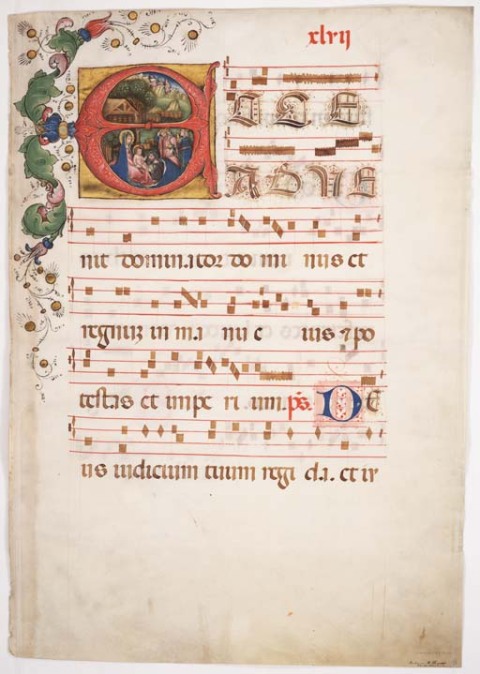Epiphany, January 6 (Northern Italy, c. 1400-1415)
April 24, 2009
Single leaf from a gradual: Initial E with the Adoration of the Magi
Northern Italy – c. 1400-1415
Script: Rotunda
Parchment with ink, paint, and gold
Notation: Square
This initial begins the Introit for the feast of Epiphany (Jan.6), “Ecce advenit dominator dominus …” (Behold, the Lord the Ruler is come). Here we have an example of more advanced technique in medieval art: there is a background and scenery with some perspective. There are out-of-scale heads over the hills in the background that are probably supposed to be shepherds in the distance, although they appear as garden gnomes carved into the side of a mountain perhaps, from our modern viewpoint.
The artist of this historiated initial is possibly a predecessor to Peronet Lamy, a Savoy artist who illuminated a full page miniature in the Morgan Library in New York, M. 180, a lectionary written by Johannes de Monterchio of Padua for Pietro Donato, bishop of Padua (1428-1447).
Free Library of Philadelphia E M 71:9
Third Mass for Christmas, December 25 (Lombardy, 1490-1510)
April 24, 2009
Single leaf from a gradual: Initial P with the
Adoration of the Christ Child
with the Shepherds, December 25
Lombardy, Italy – c. 1490-1510
Script: Rotunda
Parchment with ink, paint, and gold
Notation: Square
This image begins the Introit for the Third Mass of Christmas Day, “Puer natus est nobis et filius datus est nobis” (Unto us a child is born and unto us a son is given). An Introit for a Mass is the first sung portion of the Mass, signifying its start.
In contrast with the Austrian Nativity leaf, 65:7, there is much more detail and definition in this historiated initial P. Notice the folds in the robes of the figures, the vanishing point of the decrepit stable, and more realistic-looking faces, with light and shadow. Although this was only made twenty years or so after the Austrian manuscript, it is evident that the Italian style had already become far more advanced, as the Renaissance was well under way by this time.
Free Library of Philadelphia E M 71:14
Vigil of St. Andrew, Nov. 29
March 16, 2009
Single leaf from a gradual:
Initial D with Christ with calling Sts. Peter and Andrew
Perugia, Italy – c. 1440-1460
Script: Rotunda
Parchment with ink, paint, and gold
Notation: Square
This initial begins the Introit for the Vigil of the feast of St. Andrew (Nov. 29), “Dominus secus mare Galilee vidit duos fratres Petrum et Andream …” (The Lord, walking by the Sea of Galilee, saw two brothers Peter and Andrew). The Gospels of Matthew and Mark record that Christ came upon two fishermen in a boat on the Sea of Galilee, the brothers Peter and Andrew whom he called to be his disciples. The Gospel of John tells the story differently. It is Andrew, one of two disciples of John the Baptist, who sees Christ first and then runs to tell his brother Peter (John 1:39-41). The iconography of this initial combines the two different accounts: Andrew and Peter are fisherman, but it is Andrew who recognizes Christ first while Peter has his back turned.
The beautiful effect of gold script against a deep blue background is reminiscent of luxury manuscripts from an earlier time: during the Merovingian and Carolingian periods, manuscripts were made for kings and emperors that were stained a deep purple and written upon with gold.
This leaf is rather worse for the wear, but it allows us to see the pink gesso that was used to adhere gold leaf to the illustration. Also, the writing has worn off some: this is typical of many Italian manuscripts, as a commonly used ink had the unfortunate side-effect of eventually flaking off the vellum pages.
Free Library of Philadelphia E M 73:1


